Analysis of Business Organizations: Incorporated vs. Unincorporated
VerifiedAdded on 2022/04/04
|54
|15453
|27
Report
AI Summary
This report provides a detailed analysis of various business organizations, focusing on both incorporated and unincorporated structures. It begins with an introduction to the main types, including sole traders, partnerships (general, limited, and liability limited), private companies, and public companies. The report delves into the definition, characteristics, formation, management, and financial sources of each type, with a particular emphasis on sole traders. It outlines the steps involved in setting up a sole trader, including business name registration, responsibilities, and management models (POCCC). Furthermore, it explores sources of finance such as equity and debt capital. The report concludes with a discussion of the advantages and disadvantages associated with each business structure, offering a comprehensive overview for students studying business development.
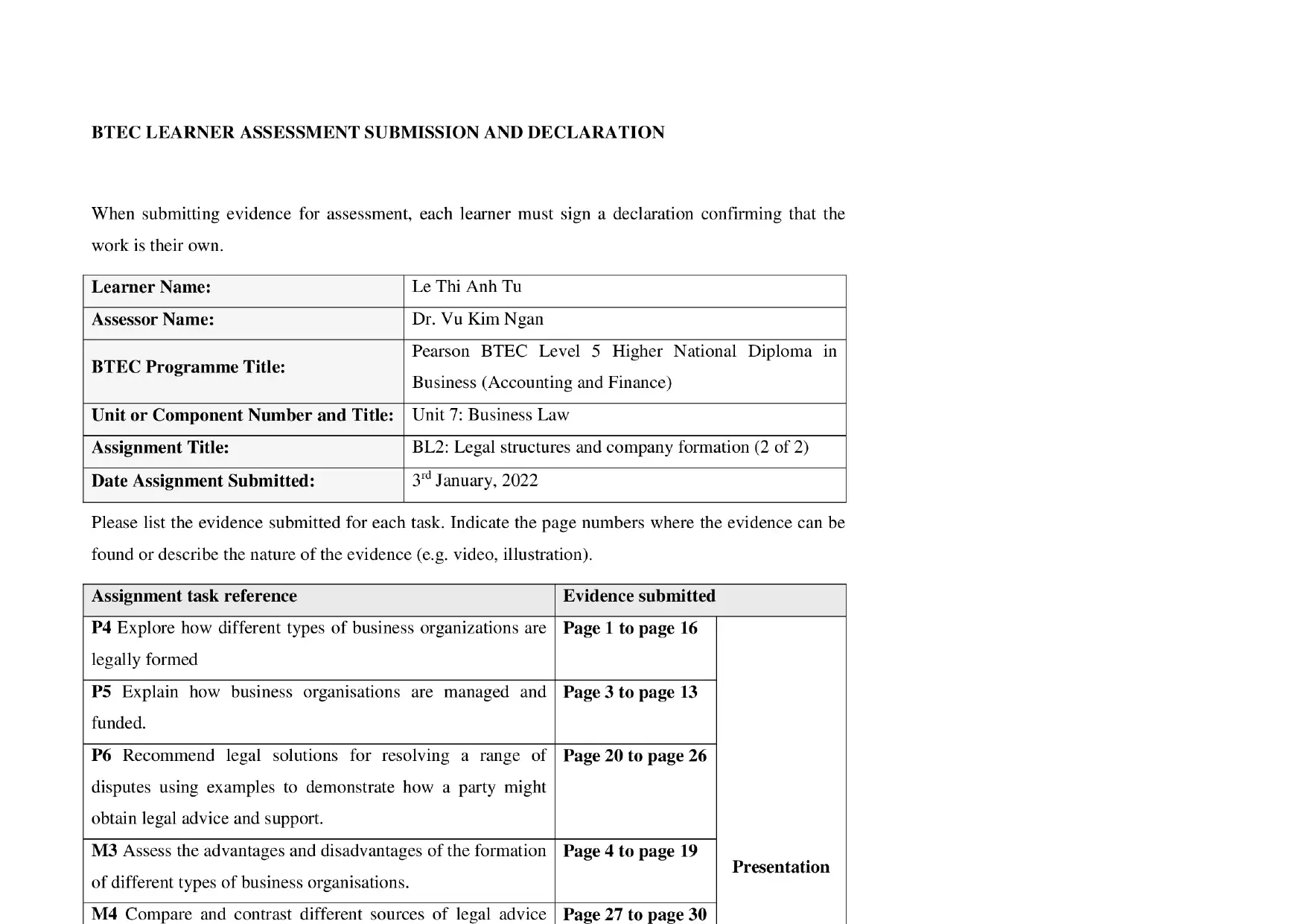
Paraphrase This Document
Need a fresh take? Get an instant paraphrase of this document with our AI Paraphraser
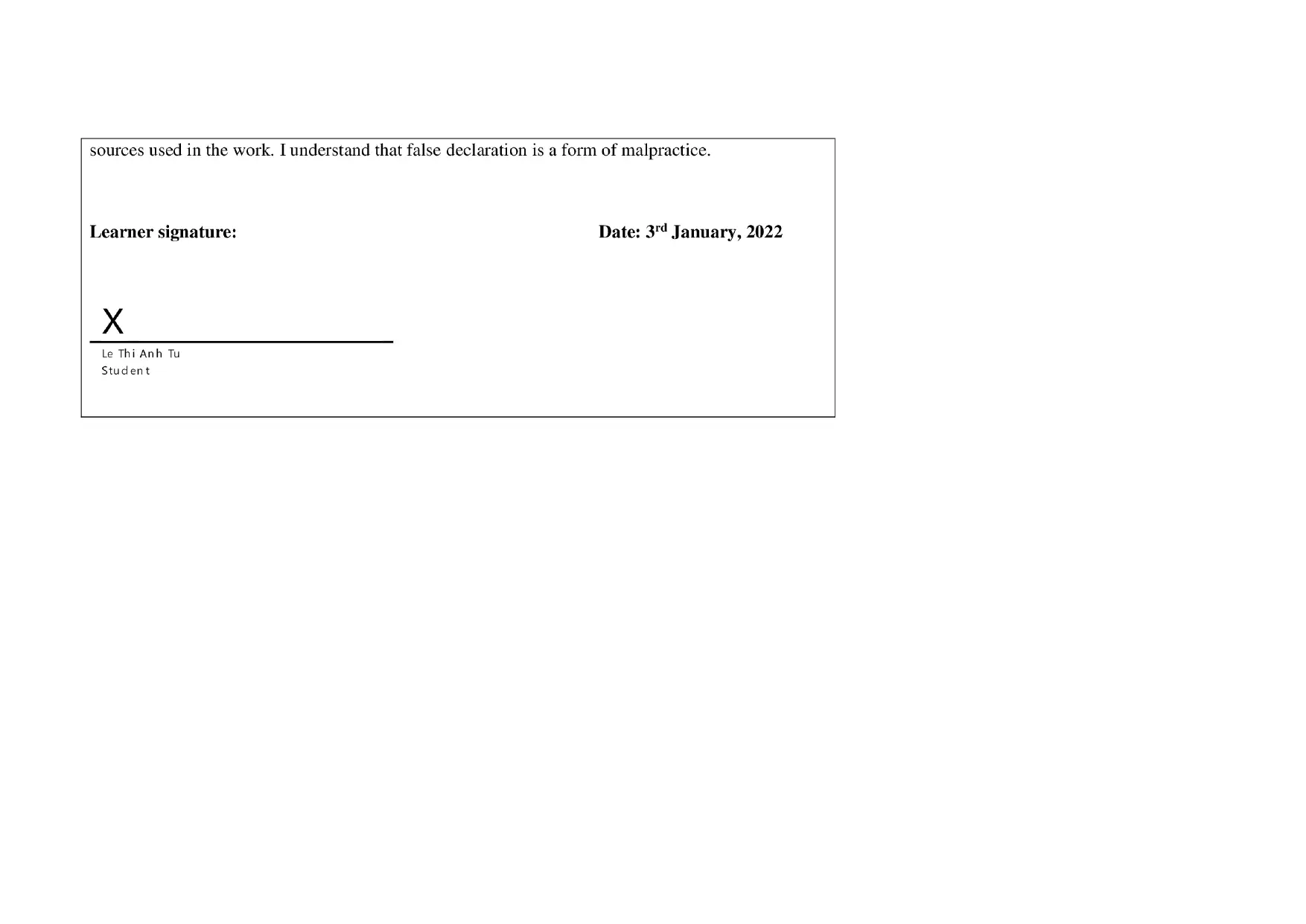
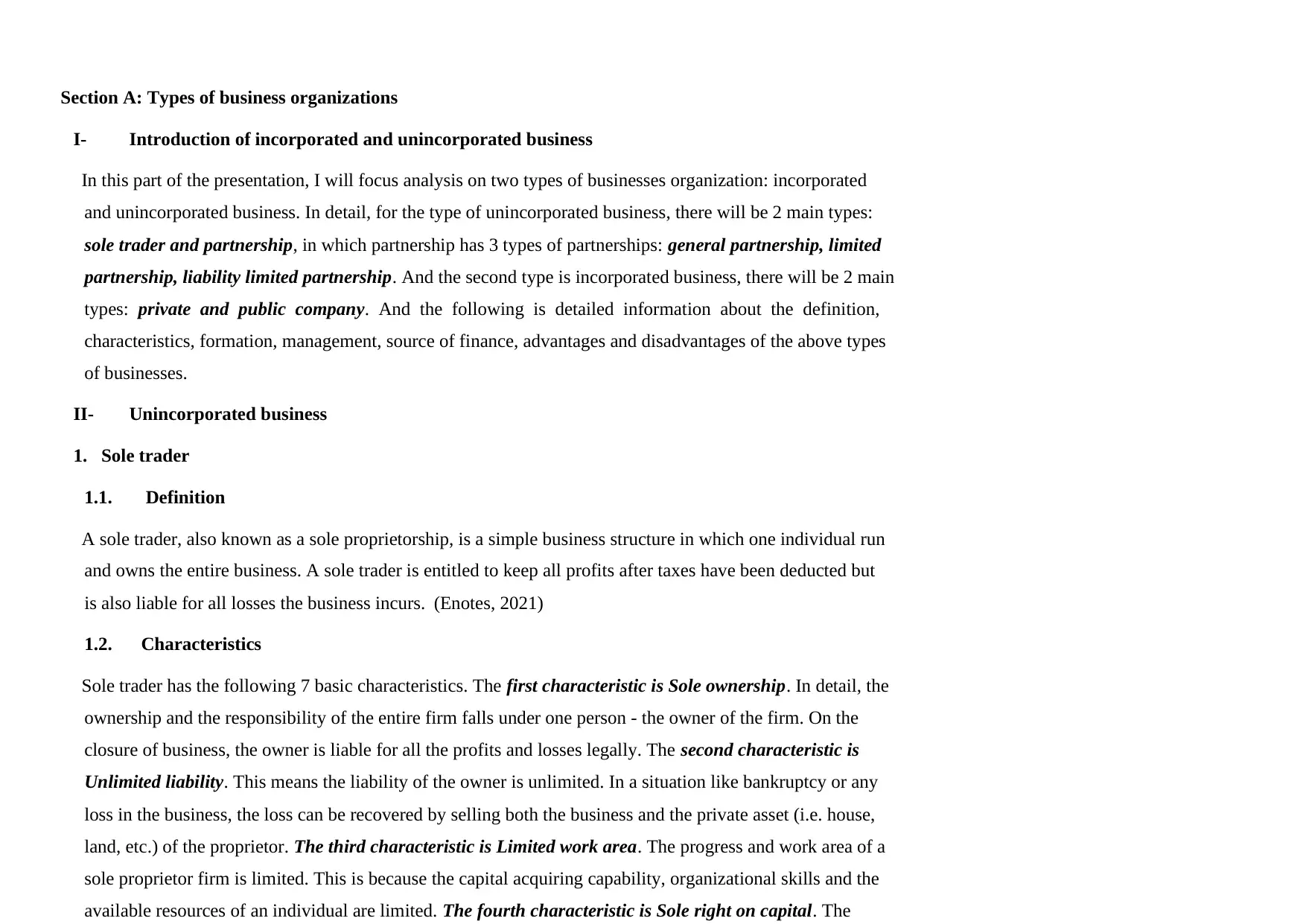
“Section A: Types of business organizations”
I- Introduction of incorporated and unincorporated business
“In this part of the presentation, I will focus analysis on two types of businesses organization: incorporated
and unincorporated business. In detail, for the type of unincorporated business, there will be 2 main types:
sole trader and partnership, in which partnership has 3 types of partnerships: general partnership, limited
partnership, liability limited partnership. And the second type is incorporated business, there will be 2 main
types: private and public company. And the following is detailed information about the definition,
characteristics, formation, management, source of finance, advantages and disadvantages of the above types
of businesses.”
II- Unincorporated business
1. Sole trader
1.1. Definition
“A sole trader, also known as a sole proprietorship, is a simple business structure in which one individual run
and owns the entire business. A sole trader is entitled to keep all profits after taxes have been deducted but
is also liable for all losses the business incurs.”(Enotes, 2021)
1.2. Characteristics
“Sole trader has the following 7 basic characteristics. The first characteristic is Sole ownership. In detail, the
ownership and the responsibility of the entire firm falls under one person - the owner of the firm. On the
closure of business, the owner is liable for all the profits and losses legally. The second characteristic is
Unlimited liability. This means the liability of the owner is unlimited. In a situation like bankruptcy or any
loss in the business, the loss can be recovered by selling both the business and the private asset (i.e. house,
land, etc.) of the proprietor. The third characteristic is Limited work area. The progress and work area of a
sole proprietor firm is limited. This is because the capital acquiring capability, organizational skills and the
available resources of an individual are limited. The fourth characteristic is Sole right on capital. The
I- Introduction of incorporated and unincorporated business
“In this part of the presentation, I will focus analysis on two types of businesses organization: incorporated
and unincorporated business. In detail, for the type of unincorporated business, there will be 2 main types:
sole trader and partnership, in which partnership has 3 types of partnerships: general partnership, limited
partnership, liability limited partnership. And the second type is incorporated business, there will be 2 main
types: private and public company. And the following is detailed information about the definition,
characteristics, formation, management, source of finance, advantages and disadvantages of the above types
of businesses.”
II- Unincorporated business
1. Sole trader
1.1. Definition
“A sole trader, also known as a sole proprietorship, is a simple business structure in which one individual run
and owns the entire business. A sole trader is entitled to keep all profits after taxes have been deducted but
is also liable for all losses the business incurs.”(Enotes, 2021)
1.2. Characteristics
“Sole trader has the following 7 basic characteristics. The first characteristic is Sole ownership. In detail, the
ownership and the responsibility of the entire firm falls under one person - the owner of the firm. On the
closure of business, the owner is liable for all the profits and losses legally. The second characteristic is
Unlimited liability. This means the liability of the owner is unlimited. In a situation like bankruptcy or any
loss in the business, the loss can be recovered by selling both the business and the private asset (i.e. house,
land, etc.) of the proprietor. The third characteristic is Limited work area. The progress and work area of a
sole proprietor firm is limited. This is because the capital acquiring capability, organizational skills and the
available resources of an individual are limited. The fourth characteristic is Sole right on capital. The
⊘ This is a preview!⊘
Do you want full access?
Subscribe today to unlock all pages.

Trusted by 1+ million students worldwide
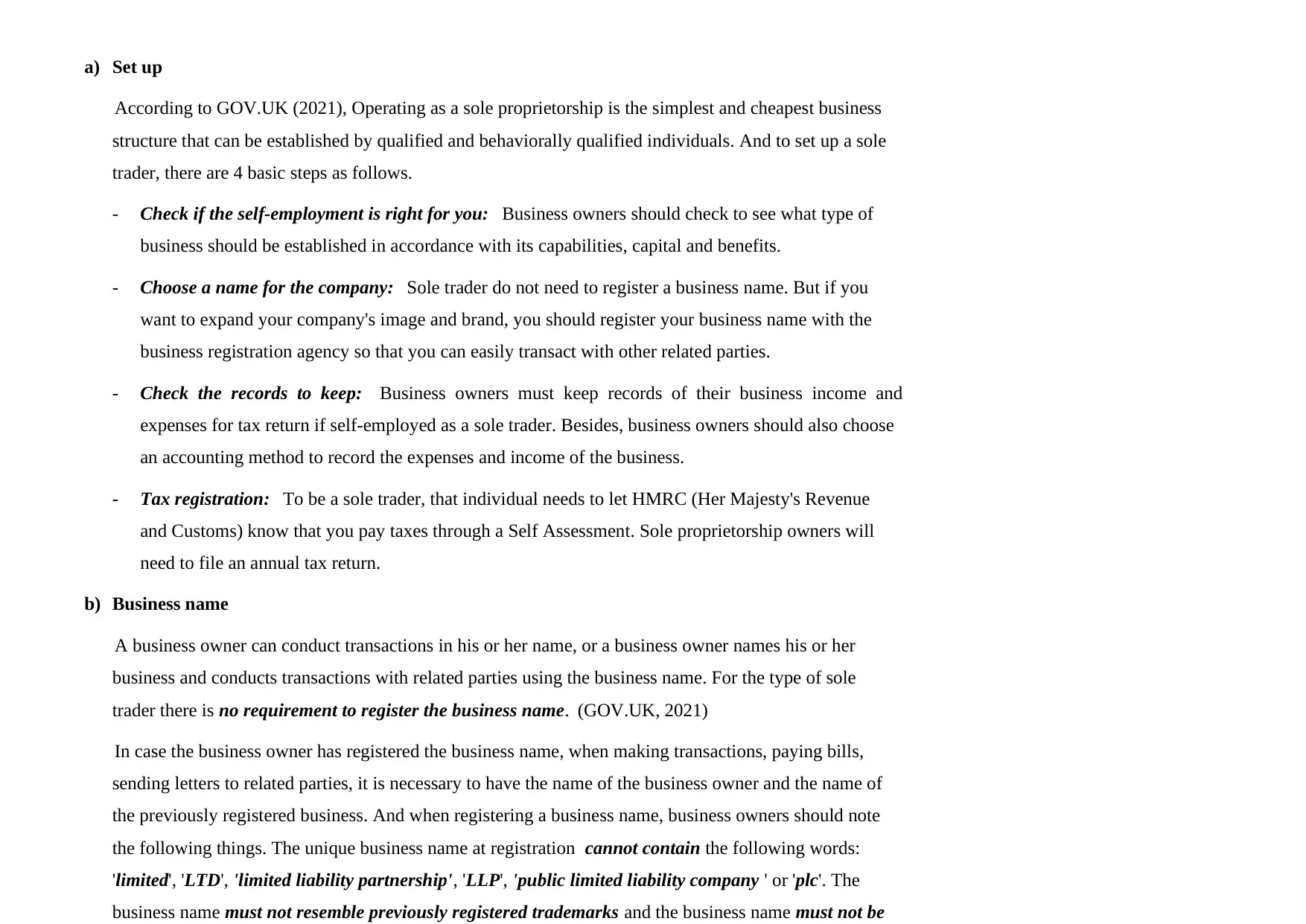
a) Set up
“According to GOV.UK (2021), Operating as a sole proprietorship is the simplest and cheapest business
structure that can be established by qualified and behaviorally qualified individuals. And to set up a sole
trader, there are 4 basic steps as follows.”
- Check if the self-employment is right for you: “Business owners should check to see what type of
business should be established in accordance with its capabilities, capital and benefits.”
- Choose a name for the company: “Sole trader do not need to register a business name. But if you
want to expand your company's image and brand, you should register your business name with the
business registration agency so that you can easily transact with other related parties.”
- Check the records to keep: “Business owners must keep records of their business income and
expenses for tax return if self-employed as a sole trader. Besides, business owners should also choose
an accounting method to record the expenses and income of the business.”
- Tax registration: “To be a sole trader, that individual needs to let HMRC (Her Majesty's Revenue
and Customs) know that you pay taxes through a Self Assessment. Sole proprietorship owners will
need to file an annual tax return.”
b) Business name
“A business owner can conduct transactions in his or her name, or a business owner names his or her
business and conducts transactions with related parties using the business name. For the type of sole
trader there is no requirement to register the business name.”(GOV.UK, 2021)
“In case the business owner has registered the business name, when making transactions, paying bills,
sending letters to related parties, it is necessary to have the name of the business owner and the name of
the previously registered business. And when registering a business name, business owners should note
the following things. The unique business name at registration cannot contain the following words:
'limited', 'LTD', 'limited liability partnership', 'LLP', 'public limited liability company ' or 'plc'. The
business name must not resemble previously registered trademarks and the business name must not be
“According to GOV.UK (2021), Operating as a sole proprietorship is the simplest and cheapest business
structure that can be established by qualified and behaviorally qualified individuals. And to set up a sole
trader, there are 4 basic steps as follows.”
- Check if the self-employment is right for you: “Business owners should check to see what type of
business should be established in accordance with its capabilities, capital and benefits.”
- Choose a name for the company: “Sole trader do not need to register a business name. But if you
want to expand your company's image and brand, you should register your business name with the
business registration agency so that you can easily transact with other related parties.”
- Check the records to keep: “Business owners must keep records of their business income and
expenses for tax return if self-employed as a sole trader. Besides, business owners should also choose
an accounting method to record the expenses and income of the business.”
- Tax registration: “To be a sole trader, that individual needs to let HMRC (Her Majesty's Revenue
and Customs) know that you pay taxes through a Self Assessment. Sole proprietorship owners will
need to file an annual tax return.”
b) Business name
“A business owner can conduct transactions in his or her name, or a business owner names his or her
business and conducts transactions with related parties using the business name. For the type of sole
trader there is no requirement to register the business name.”(GOV.UK, 2021)
“In case the business owner has registered the business name, when making transactions, paying bills,
sending letters to related parties, it is necessary to have the name of the business owner and the name of
the previously registered business. And when registering a business name, business owners should note
the following things. The unique business name at registration cannot contain the following words:
'limited', 'LTD', 'limited liability partnership', 'LLP', 'public limited liability company ' or 'plc'. The
business name must not resemble previously registered trademarks and the business name must not be
Paraphrase This Document
Need a fresh take? Get an instant paraphrase of this document with our AI Paraphraser
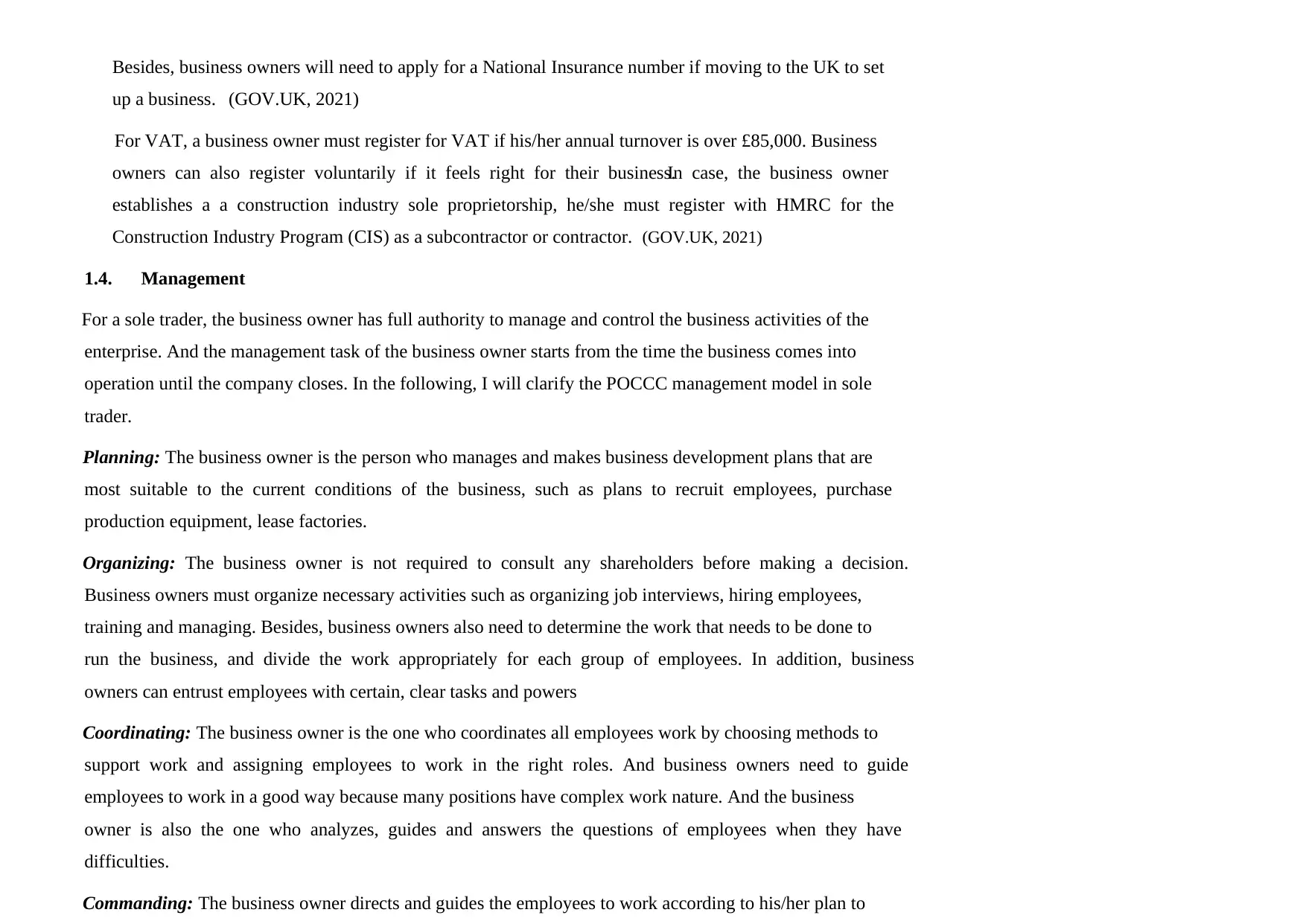
Besides, business owners will need to apply for a National Insurance number if moving to the UK to set
up a business.” (GOV.UK, 2021)
“For VAT, a business owner must register for VAT if his/her annual turnover is over £85,000. Business
owners can also register voluntarily if it feels right for their business.In case, the business owner
establishes a a construction industry sole proprietorship, he/she must register with HMRC for the
Construction Industry Program (CIS) as a subcontractor or contractor.”(GOV.UK, 2021)
1.4. Management
“For a sole trader, the business owner has full authority to manage and control the business activities of the
enterprise. And the management task of the business owner starts from the time the business comes into
operation until the company closes. In the following, I will clarify the POCCC management model in sole
trader.”
“Planning: The business owner is the person who manages and makes business development plans that are
most suitable to the current conditions of the business, such as plans to recruit employees, purchase
production equipment, lease factories.”
“Organizing: The business owner is not required to consult any shareholders before making a decision.
Business owners must organize necessary activities such as organizing job interviews, hiring employees,
training and managing. Besides, business owners also need to determine the work that needs to be done to
run the business, and divide the work appropriately for each group of employees. In addition, business
owners can entrust employees with certain, clear tasks and powers”
“Coordinating: The business owner is the one who coordinates all employees work by choosing methods to
support work and assigning employees to work in the right roles. And business owners need to guide
employees to work in a good way because many positions have complex work nature. And the business
owner is also the one who analyzes, guides and answers the questions of employees when they have
difficulties.”
“Commanding: The business owner directs and guides the employees to work according to his/her plan to
up a business.” (GOV.UK, 2021)
“For VAT, a business owner must register for VAT if his/her annual turnover is over £85,000. Business
owners can also register voluntarily if it feels right for their business.In case, the business owner
establishes a a construction industry sole proprietorship, he/she must register with HMRC for the
Construction Industry Program (CIS) as a subcontractor or contractor.”(GOV.UK, 2021)
1.4. Management
“For a sole trader, the business owner has full authority to manage and control the business activities of the
enterprise. And the management task of the business owner starts from the time the business comes into
operation until the company closes. In the following, I will clarify the POCCC management model in sole
trader.”
“Planning: The business owner is the person who manages and makes business development plans that are
most suitable to the current conditions of the business, such as plans to recruit employees, purchase
production equipment, lease factories.”
“Organizing: The business owner is not required to consult any shareholders before making a decision.
Business owners must organize necessary activities such as organizing job interviews, hiring employees,
training and managing. Besides, business owners also need to determine the work that needs to be done to
run the business, and divide the work appropriately for each group of employees. In addition, business
owners can entrust employees with certain, clear tasks and powers”
“Coordinating: The business owner is the one who coordinates all employees work by choosing methods to
support work and assigning employees to work in the right roles. And business owners need to guide
employees to work in a good way because many positions have complex work nature. And the business
owner is also the one who analyzes, guides and answers the questions of employees when they have
difficulties.”
“Commanding: The business owner directs and guides the employees to work according to his/her plan to
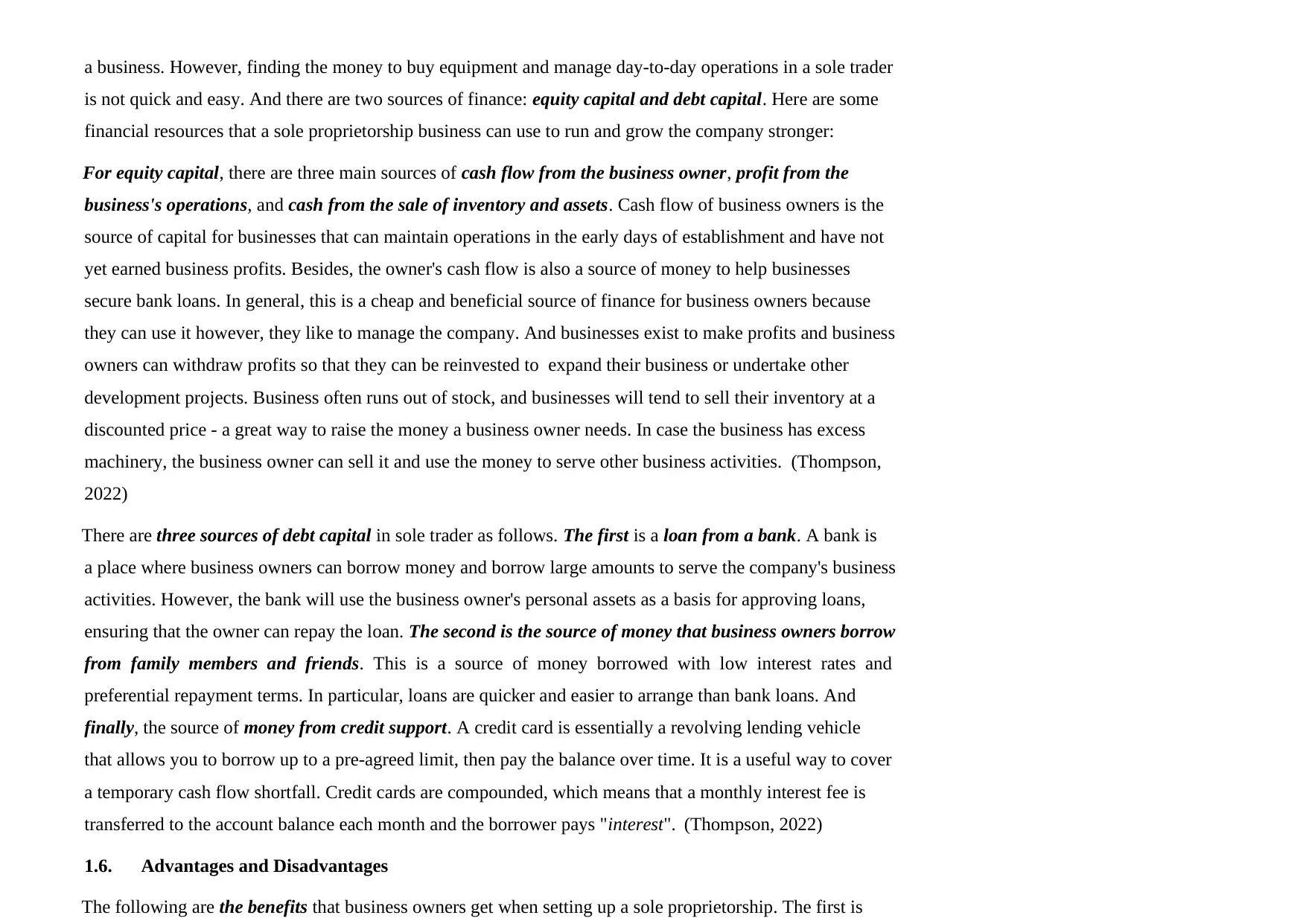
a business. However, finding the money to buy equipment and manage day-to-day operations in a sole trader
is not quick and easy. And there are two sources of finance: equity capital and debt capital. Here are some
financial resources that a sole proprietorship business can use to run and grow the company stronger:
“For equity capital, there are three main sources of cash flow from the business owner, profit from the
business's operations, and cash from the sale of inventory and assets. Cash flow of business owners is the
source of capital for businesses that can maintain operations in the early days of establishment and have not
yet earned business profits. Besides, the owner's cash flow is also a source of money to help businesses
secure bank loans. In general, this is a cheap and beneficial source of finance for business owners because
they can use it however, they like to manage the company. And businesses exist to make profits and business
owners can withdraw profits so that they can be reinvested to expand their business or undertake other
development projects. Business often runs out of stock, and businesses will tend to sell their inventory at a
discounted price - a great way to raise the money a business owner needs. In case the business has excess
machinery, the business owner can sell it and use the money to serve other business activities.”(Thompson,
2022)
“There are three sources of debt capital in sole trader as follows. The first is a loan from a bank. A bank is
a place where business owners can borrow money and borrow large amounts to serve the company's business
activities. However, the bank will use the business owner's personal assets as a basis for approving loans,
ensuring that the owner can repay the loan. The second is the source of money that business owners borrow
from family members and friends. This is a source of money borrowed with low interest rates and
preferential repayment terms. In particular, loans are quicker and easier to arrange than bank loans. And
finally, the source of money from credit support. A credit card is essentially a revolving lending vehicle
that allows you to borrow up to a pre-agreed limit, then pay the balance over time. It is a useful way to cover
a temporary cash flow shortfall. Credit cards are compounded, which means that a monthly interest fee is
transferred to the account balance each month and the borrower pays "interest".”(Thompson, 2022)
1.6. Advantages and Disadvantages
“The following are the benefits that business owners get when setting up a sole proprietorship. The first is
is not quick and easy. And there are two sources of finance: equity capital and debt capital. Here are some
financial resources that a sole proprietorship business can use to run and grow the company stronger:
“For equity capital, there are three main sources of cash flow from the business owner, profit from the
business's operations, and cash from the sale of inventory and assets. Cash flow of business owners is the
source of capital for businesses that can maintain operations in the early days of establishment and have not
yet earned business profits. Besides, the owner's cash flow is also a source of money to help businesses
secure bank loans. In general, this is a cheap and beneficial source of finance for business owners because
they can use it however, they like to manage the company. And businesses exist to make profits and business
owners can withdraw profits so that they can be reinvested to expand their business or undertake other
development projects. Business often runs out of stock, and businesses will tend to sell their inventory at a
discounted price - a great way to raise the money a business owner needs. In case the business has excess
machinery, the business owner can sell it and use the money to serve other business activities.”(Thompson,
2022)
“There are three sources of debt capital in sole trader as follows. The first is a loan from a bank. A bank is
a place where business owners can borrow money and borrow large amounts to serve the company's business
activities. However, the bank will use the business owner's personal assets as a basis for approving loans,
ensuring that the owner can repay the loan. The second is the source of money that business owners borrow
from family members and friends. This is a source of money borrowed with low interest rates and
preferential repayment terms. In particular, loans are quicker and easier to arrange than bank loans. And
finally, the source of money from credit support. A credit card is essentially a revolving lending vehicle
that allows you to borrow up to a pre-agreed limit, then pay the balance over time. It is a useful way to cover
a temporary cash flow shortfall. Credit cards are compounded, which means that a monthly interest fee is
transferred to the account balance each month and the borrower pays "interest".”(Thompson, 2022)
1.6. Advantages and Disadvantages
“The following are the benefits that business owners get when setting up a sole proprietorship. The first is
⊘ This is a preview!⊘
Do you want full access?
Subscribe today to unlock all pages.

Trusted by 1+ million students worldwide
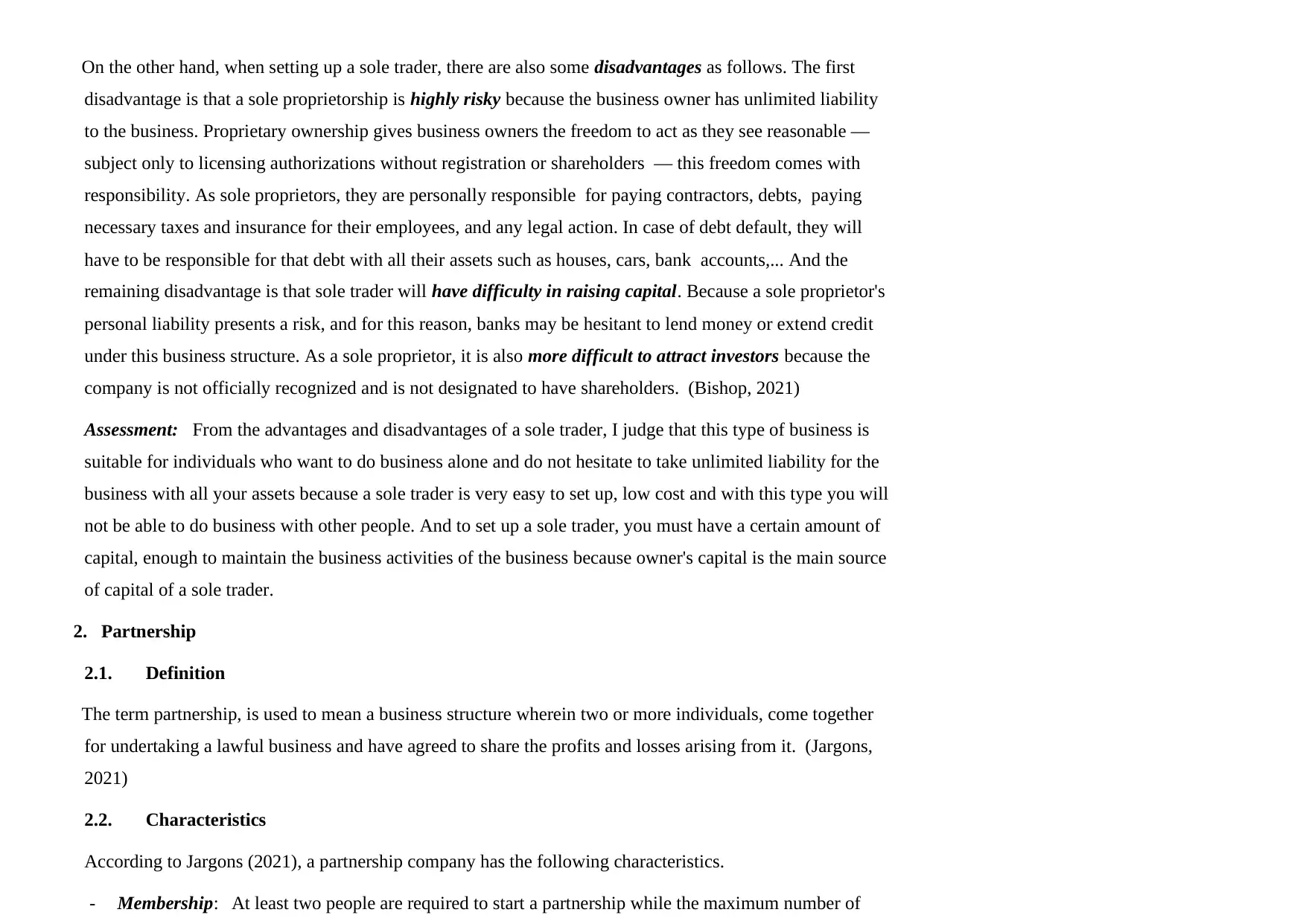
“On the other hand, when setting up a sole trader, there are also some disadvantages as follows. The first
disadvantage is that a sole proprietorship is highly risky because the business owner has unlimited liability
to the business. Proprietary ownership gives business owners the freedom to act as they see reasonable —
subject only to licensing authorizations without registration or shareholders — this freedom comes with
responsibility. As sole proprietors, they are personally responsible for paying contractors, debts, paying
necessary taxes and insurance for their employees, and any legal action. In case of debt default, they will
have to be responsible for that debt with all their assets such as houses, cars, bank accounts,... And the
remaining disadvantage is that sole trader will have difficulty in raising capital. Because a sole proprietor's
personal liability presents a risk, and for this reason, banks may be hesitant to lend money or extend credit
under this business structure. As a sole proprietor, it is also more difficult to attract investors because the
company is not officially recognized and is not designated to have shareholders.”(Bishop, 2021)
Assessment: “From the advantages and disadvantages of a sole trader, I judge that this type of business is
suitable for individuals who want to do business alone and do not hesitate to take unlimited liability for the
business with all your assets because a sole trader is very easy to set up, low cost and with this type you will
not be able to do business with other people. And to set up a sole trader, you must have a certain amount of
capital, enough to maintain the business activities of the business because owner's capital is the main source
of capital of a sole trader.”
2. Partnership
2.1. Definition
“The term partnership, is used to mean a business structure wherein two or more individuals, come together
for undertaking a lawful business and have agreed to share the profits and losses arising from it.”(Jargons,
2021)
2.2. Characteristics
According to Jargons (2021), a partnership company has the following characteristics.
- Membership: “At least two people are required to start a partnership while the maximum number of
disadvantage is that a sole proprietorship is highly risky because the business owner has unlimited liability
to the business. Proprietary ownership gives business owners the freedom to act as they see reasonable —
subject only to licensing authorizations without registration or shareholders — this freedom comes with
responsibility. As sole proprietors, they are personally responsible for paying contractors, debts, paying
necessary taxes and insurance for their employees, and any legal action. In case of debt default, they will
have to be responsible for that debt with all their assets such as houses, cars, bank accounts,... And the
remaining disadvantage is that sole trader will have difficulty in raising capital. Because a sole proprietor's
personal liability presents a risk, and for this reason, banks may be hesitant to lend money or extend credit
under this business structure. As a sole proprietor, it is also more difficult to attract investors because the
company is not officially recognized and is not designated to have shareholders.”(Bishop, 2021)
Assessment: “From the advantages and disadvantages of a sole trader, I judge that this type of business is
suitable for individuals who want to do business alone and do not hesitate to take unlimited liability for the
business with all your assets because a sole trader is very easy to set up, low cost and with this type you will
not be able to do business with other people. And to set up a sole trader, you must have a certain amount of
capital, enough to maintain the business activities of the business because owner's capital is the main source
of capital of a sole trader.”
2. Partnership
2.1. Definition
“The term partnership, is used to mean a business structure wherein two or more individuals, come together
for undertaking a lawful business and have agreed to share the profits and losses arising from it.”(Jargons,
2021)
2.2. Characteristics
According to Jargons (2021), a partnership company has the following characteristics.
- Membership: “At least two people are required to start a partnership while the maximum number of
Paraphrase This Document
Need a fresh take? Get an instant paraphrase of this document with our AI Paraphraser
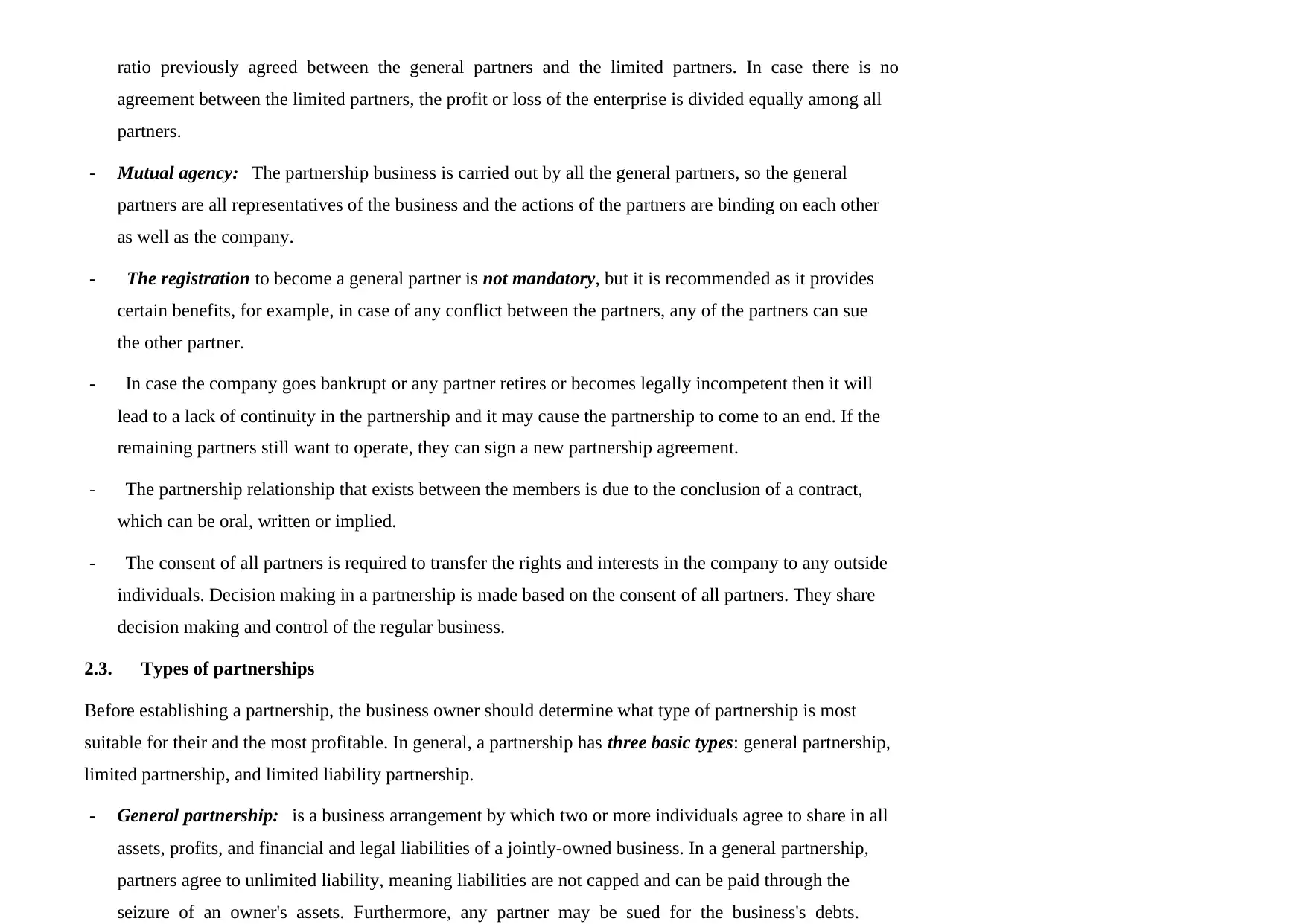
ratio previously agreed between the general partners and the limited partners. In case there is no
agreement between the limited partners, the profit or loss of the enterprise is divided equally among all
partners.”
- Mutual agency: “The partnership business is carried out by all the general partners, so the general
partners are all representatives of the business and the actions of the partners are binding on each other
as well as the company.”
- “The registration to become a general partner is not mandatory, but it is recommended as it provides
certain benefits, for example, in case of any conflict between the partners, any of the partners can sue
the other partner.”
- “In case the company goes bankrupt or any partner retires or becomes legally incompetent then it will
lead to a lack of continuity in the partnership and it may cause the partnership to come to an end. If the
remaining partners still want to operate, they can sign a new partnership agreement.”
- “The partnership relationship that exists between the members is due to the conclusion of a contract,
which can be oral, written or implied.”
- “The consent of all partners is required to transfer the rights and interests in the company to any outside
individuals. Decision making in a partnership is made based on the consent of all partners. They share
decision making and control of the regular business.”
2.3. Types of partnerships
Before establishing a partnership, the business owner should determine what type of partnership is most
suitable for their and the most profitable. In general, a partnership has three basic types: general partnership,
limited partnership, and limited liability partnership.
- General partnership: “is a business arrangement by which two or more individuals agree to share in all
assets, profits, and financial and legal liabilities of a jointly-owned business. In a general partnership,
partners agree to unlimited liability, meaning liabilities are not capped and can be paid through the
seizure of an owner's assets. Furthermore, any partner may be sued for the business's debts.”
agreement between the limited partners, the profit or loss of the enterprise is divided equally among all
partners.”
- Mutual agency: “The partnership business is carried out by all the general partners, so the general
partners are all representatives of the business and the actions of the partners are binding on each other
as well as the company.”
- “The registration to become a general partner is not mandatory, but it is recommended as it provides
certain benefits, for example, in case of any conflict between the partners, any of the partners can sue
the other partner.”
- “In case the company goes bankrupt or any partner retires or becomes legally incompetent then it will
lead to a lack of continuity in the partnership and it may cause the partnership to come to an end. If the
remaining partners still want to operate, they can sign a new partnership agreement.”
- “The partnership relationship that exists between the members is due to the conclusion of a contract,
which can be oral, written or implied.”
- “The consent of all partners is required to transfer the rights and interests in the company to any outside
individuals. Decision making in a partnership is made based on the consent of all partners. They share
decision making and control of the regular business.”
2.3. Types of partnerships
Before establishing a partnership, the business owner should determine what type of partnership is most
suitable for their and the most profitable. In general, a partnership has three basic types: general partnership,
limited partnership, and limited liability partnership.
- General partnership: “is a business arrangement by which two or more individuals agree to share in all
assets, profits, and financial and legal liabilities of a jointly-owned business. In a general partnership,
partners agree to unlimited liability, meaning liabilities are not capped and can be paid through the
seizure of an owner's assets. Furthermore, any partner may be sued for the business's debts.”
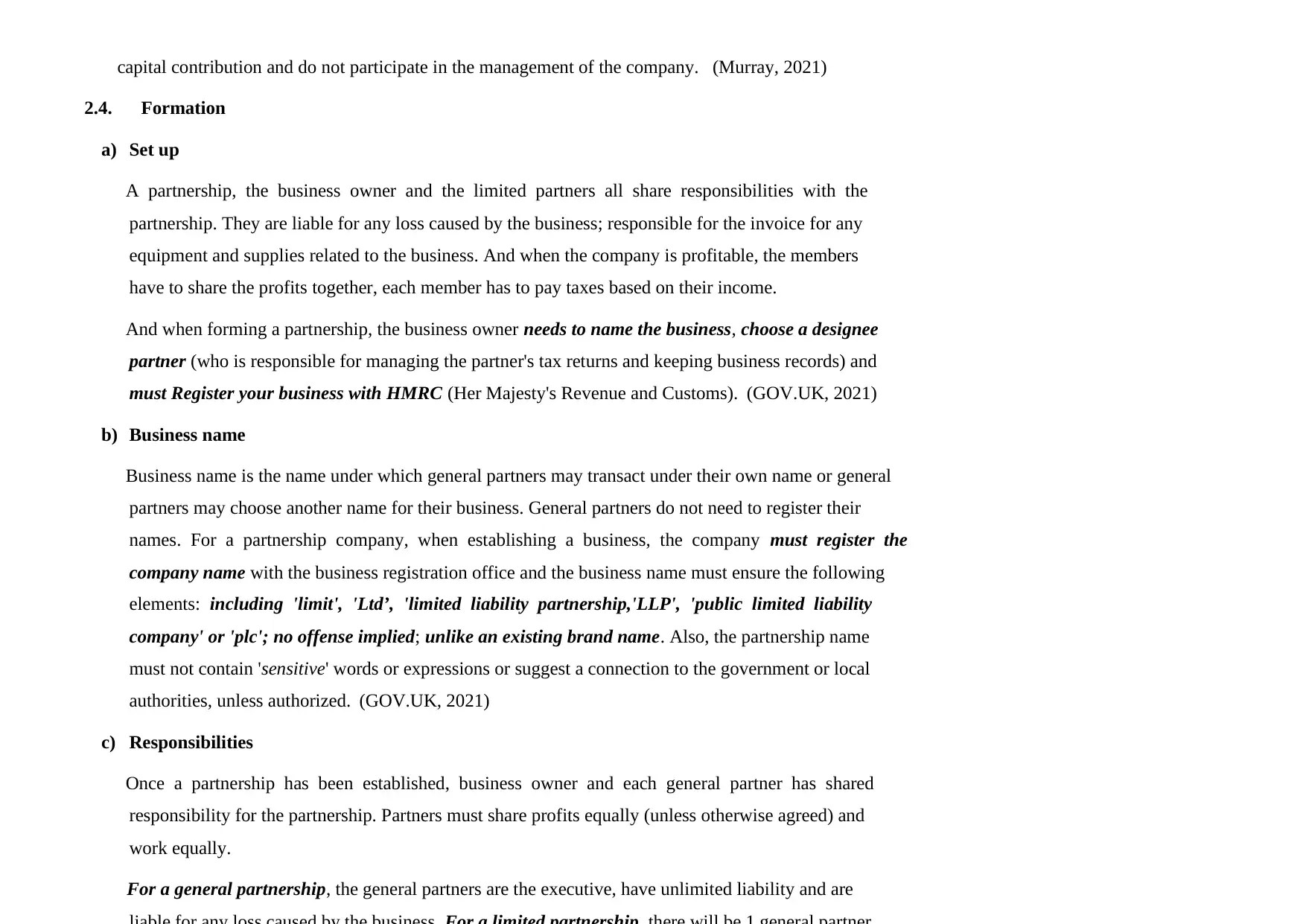
capital contribution and do not participate in the management of the company.” (Murray, 2021)
2.4. Formation
a) Set up
“A partnership, the business owner and the limited partners all share responsibilities with the
partnership. They are liable for any loss caused by the business; responsible for the invoice for any
equipment and supplies related to the business. And when the company is profitable, the members
have to share the profits together, each member has to pay taxes based on their income.”
“And when forming a partnership, the business owner needs to name the business, choose a designee
partner (who is responsible for managing the partner's tax returns and keeping business records) and
must Register your business with HMRC (Her Majesty's Revenue and Customs).”(GOV.UK, 2021)
b) Business name
“Business name is the name under which general partners may transact under their own name or general
partners may choose another name for their business. General partners do not need to register their
names. For a partnership company, when establishing a business, the company must register the
company name with the business registration office and the business name must ensure the following
elements: including 'limit', 'Ltd’, 'limited liability partnership,'LLP', 'public limited liability
company' or 'plc'; no offense implied; unlike an existing brand name. Also, the partnership name
must not contain 'sensitive' words or expressions or suggest a connection to the government or local
authorities, unless authorized.”(GOV.UK, 2021)
c) Responsibilities
“Once a partnership has been established, business owner and each general partner has shared
responsibility for the partnership. Partners must share profits equally (unless otherwise agreed) and
work equally.”
“For a general partnership, the general partners are the executive, have unlimited liability and are
2.4. Formation
a) Set up
“A partnership, the business owner and the limited partners all share responsibilities with the
partnership. They are liable for any loss caused by the business; responsible for the invoice for any
equipment and supplies related to the business. And when the company is profitable, the members
have to share the profits together, each member has to pay taxes based on their income.”
“And when forming a partnership, the business owner needs to name the business, choose a designee
partner (who is responsible for managing the partner's tax returns and keeping business records) and
must Register your business with HMRC (Her Majesty's Revenue and Customs).”(GOV.UK, 2021)
b) Business name
“Business name is the name under which general partners may transact under their own name or general
partners may choose another name for their business. General partners do not need to register their
names. For a partnership company, when establishing a business, the company must register the
company name with the business registration office and the business name must ensure the following
elements: including 'limit', 'Ltd’, 'limited liability partnership,'LLP', 'public limited liability
company' or 'plc'; no offense implied; unlike an existing brand name. Also, the partnership name
must not contain 'sensitive' words or expressions or suggest a connection to the government or local
authorities, unless authorized.”(GOV.UK, 2021)
c) Responsibilities
“Once a partnership has been established, business owner and each general partner has shared
responsibility for the partnership. Partners must share profits equally (unless otherwise agreed) and
work equally.”
“For a general partnership, the general partners are the executive, have unlimited liability and are
⊘ This is a preview!⊘
Do you want full access?
Subscribe today to unlock all pages.

Trusted by 1+ million students worldwide
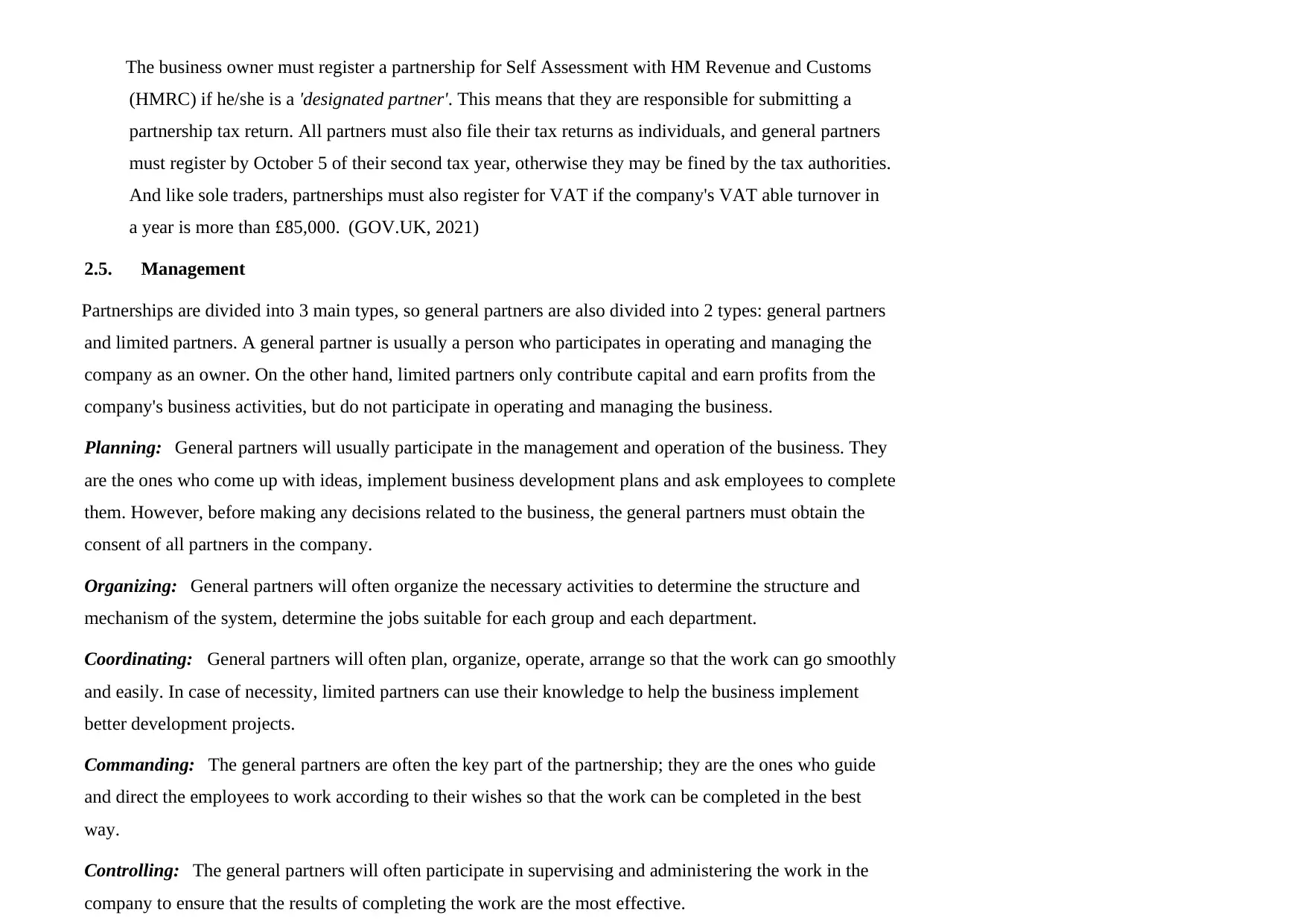
“The business owner must register a partnership for Self Assessment with HM Revenue and Customs
(HMRC) if he/she is a 'designated partner'. This means that they are responsible for submitting a
partnership tax return. All partners must also file their tax returns as individuals, and general partners
must register by October 5 of their second tax year, otherwise they may be fined by the tax authorities.
And like sole traders, partnerships must also register for VAT if the company's VAT able turnover in
a year is more than £85,000.”(GOV.UK, 2021)
2.5. Management
“Partnerships are divided into 3 main types, so general partners are also divided into 2 types: general partners
and limited partners. A general partner is usually a person who participates in operating and managing the
company as an owner. On the other hand, limited partners only contribute capital and earn profits from the
company's business activities, but do not participate in operating and managing the business.”
Planning: “General partners will usually participate in the management and operation of the business. They
are the ones who come up with ideas, implement business development plans and ask employees to complete
them. However, before making any decisions related to the business, the general partners must obtain the
consent of all partners in the company.”
Organizing: “General partners will often organize the necessary activities to determine the structure and
mechanism of the system, determine the jobs suitable for each group and each department.”
Coordinating: “General partners will often plan, organize, operate, arrange so that the work can go smoothly
and easily. In case of necessity, limited partners can use their knowledge to help the business implement
better development projects.”
Commanding: “The general partners are often the key part of the partnership; they are the ones who guide
and direct the employees to work according to their wishes so that the work can be completed in the best
way.”
Controlling: “The general partners will often participate in supervising and administering the work in the
company to ensure that the results of completing the work are the most effective.”
(HMRC) if he/she is a 'designated partner'. This means that they are responsible for submitting a
partnership tax return. All partners must also file their tax returns as individuals, and general partners
must register by October 5 of their second tax year, otherwise they may be fined by the tax authorities.
And like sole traders, partnerships must also register for VAT if the company's VAT able turnover in
a year is more than £85,000.”(GOV.UK, 2021)
2.5. Management
“Partnerships are divided into 3 main types, so general partners are also divided into 2 types: general partners
and limited partners. A general partner is usually a person who participates in operating and managing the
company as an owner. On the other hand, limited partners only contribute capital and earn profits from the
company's business activities, but do not participate in operating and managing the business.”
Planning: “General partners will usually participate in the management and operation of the business. They
are the ones who come up with ideas, implement business development plans and ask employees to complete
them. However, before making any decisions related to the business, the general partners must obtain the
consent of all partners in the company.”
Organizing: “General partners will often organize the necessary activities to determine the structure and
mechanism of the system, determine the jobs suitable for each group and each department.”
Coordinating: “General partners will often plan, organize, operate, arrange so that the work can go smoothly
and easily. In case of necessity, limited partners can use their knowledge to help the business implement
better development projects.”
Commanding: “The general partners are often the key part of the partnership; they are the ones who guide
and direct the employees to work according to their wishes so that the work can be completed in the best
way.”
Controlling: “The general partners will often participate in supervising and administering the work in the
company to ensure that the results of completing the work are the most effective.”
Paraphrase This Document
Need a fresh take? Get an instant paraphrase of this document with our AI Paraphraser
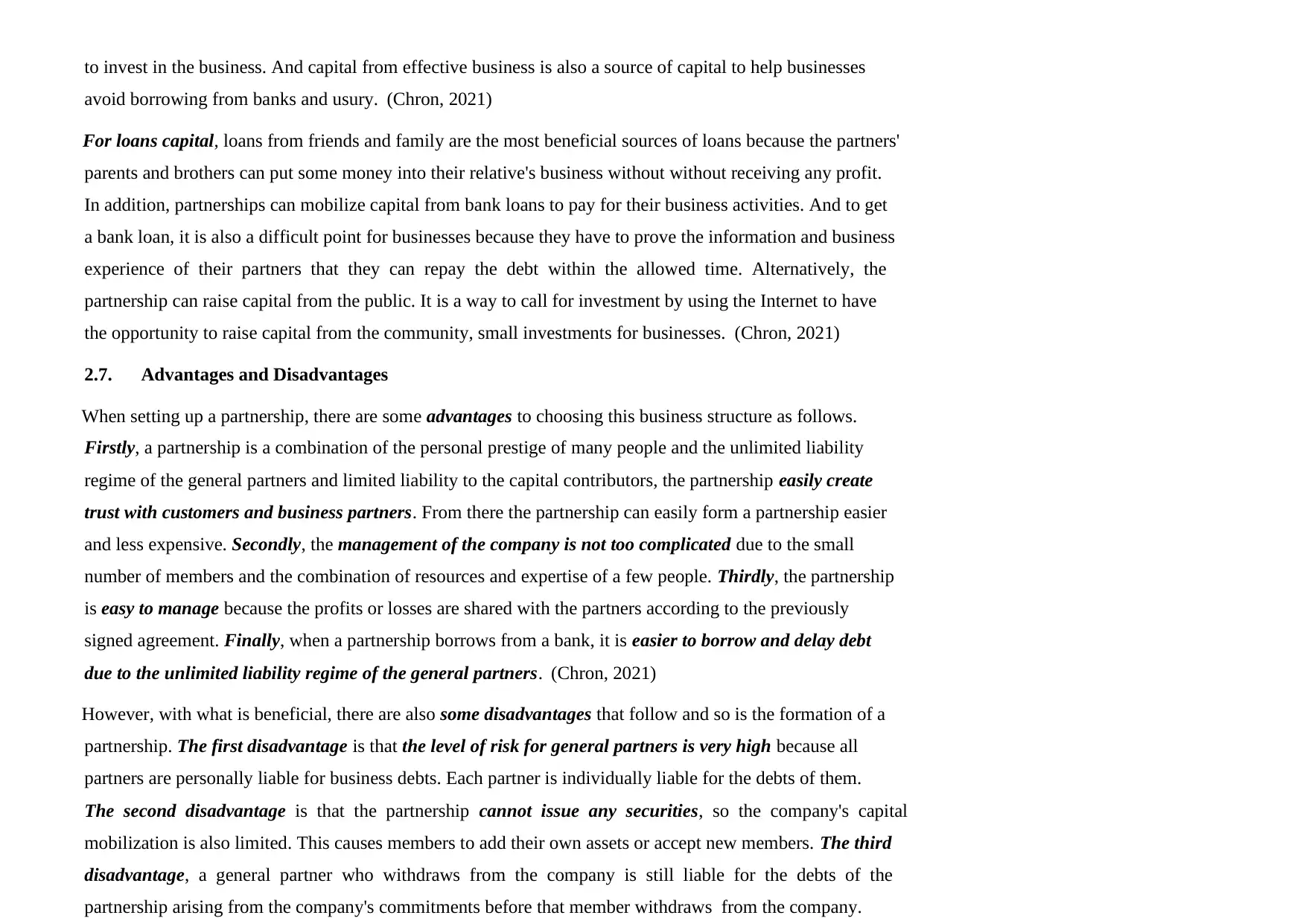
to invest in the business. And capital from effective business is also a source of capital to help businesses
avoid borrowing from banks and usury.”(Chron, 2021)
“For loans capital, loans from friends and family are the most beneficial sources of loans because the partners'
parents and brothers can put some money into their relative's business without without receiving any profit.
In addition, partnerships can mobilize capital from bank loans to pay for their business activities. And to get
a bank loan, it is also a difficult point for businesses because they have to prove the information and business
experience of their partners that they can repay the debt within the allowed time. Alternatively, the
partnership can raise capital from the public. It is a way to call for investment by using the Internet to have
the opportunity to raise capital from the community, small investments for businesses.”(Chron, 2021)
2.7. Advantages and Disadvantages
“When setting up a partnership, there are some advantages to choosing this business structure as follows.
Firstly, a partnership is a combination of the personal prestige of many people and the unlimited liability
regime of the general partners and limited liability to the capital contributors, the partnership easily create
trust with customers and business partners. From there the partnership can easily form a partnership easier
and less expensive. Secondly, the management of the company is not too complicated due to the small
number of members and the combination of resources and expertise of a few people. Thirdly, the partnership
is easy to manage because the profits or losses are shared with the partners according to the previously
signed agreement. Finally, when a partnership borrows from a bank, it is easier to borrow and delay debt
due to the unlimited liability regime of the general partners.”(Chron, 2021)
“However, with what is beneficial, there are also some disadvantages that follow and so is the formation of a
partnership. The first disadvantage is that the level of risk for general partners is very high because all
partners are personally liable for business debts. Each partner is individually liable for the debts of them.
The second disadvantage is that the partnership cannot issue any securities, so the company's capital
mobilization is also limited. This causes members to add their own assets or accept new members. The third
disadvantage, a general partner who withdraws from the company is still liable for the debts of the
partnership arising from the company's commitments before that member withdraws from the company.
avoid borrowing from banks and usury.”(Chron, 2021)
“For loans capital, loans from friends and family are the most beneficial sources of loans because the partners'
parents and brothers can put some money into their relative's business without without receiving any profit.
In addition, partnerships can mobilize capital from bank loans to pay for their business activities. And to get
a bank loan, it is also a difficult point for businesses because they have to prove the information and business
experience of their partners that they can repay the debt within the allowed time. Alternatively, the
partnership can raise capital from the public. It is a way to call for investment by using the Internet to have
the opportunity to raise capital from the community, small investments for businesses.”(Chron, 2021)
2.7. Advantages and Disadvantages
“When setting up a partnership, there are some advantages to choosing this business structure as follows.
Firstly, a partnership is a combination of the personal prestige of many people and the unlimited liability
regime of the general partners and limited liability to the capital contributors, the partnership easily create
trust with customers and business partners. From there the partnership can easily form a partnership easier
and less expensive. Secondly, the management of the company is not too complicated due to the small
number of members and the combination of resources and expertise of a few people. Thirdly, the partnership
is easy to manage because the profits or losses are shared with the partners according to the previously
signed agreement. Finally, when a partnership borrows from a bank, it is easier to borrow and delay debt
due to the unlimited liability regime of the general partners.”(Chron, 2021)
“However, with what is beneficial, there are also some disadvantages that follow and so is the formation of a
partnership. The first disadvantage is that the level of risk for general partners is very high because all
partners are personally liable for business debts. Each partner is individually liable for the debts of them.
The second disadvantage is that the partnership cannot issue any securities, so the company's capital
mobilization is also limited. This causes members to add their own assets or accept new members. The third
disadvantage, a general partner who withdraws from the company is still liable for the debts of the
partnership arising from the company's commitments before that member withdraws from the company.
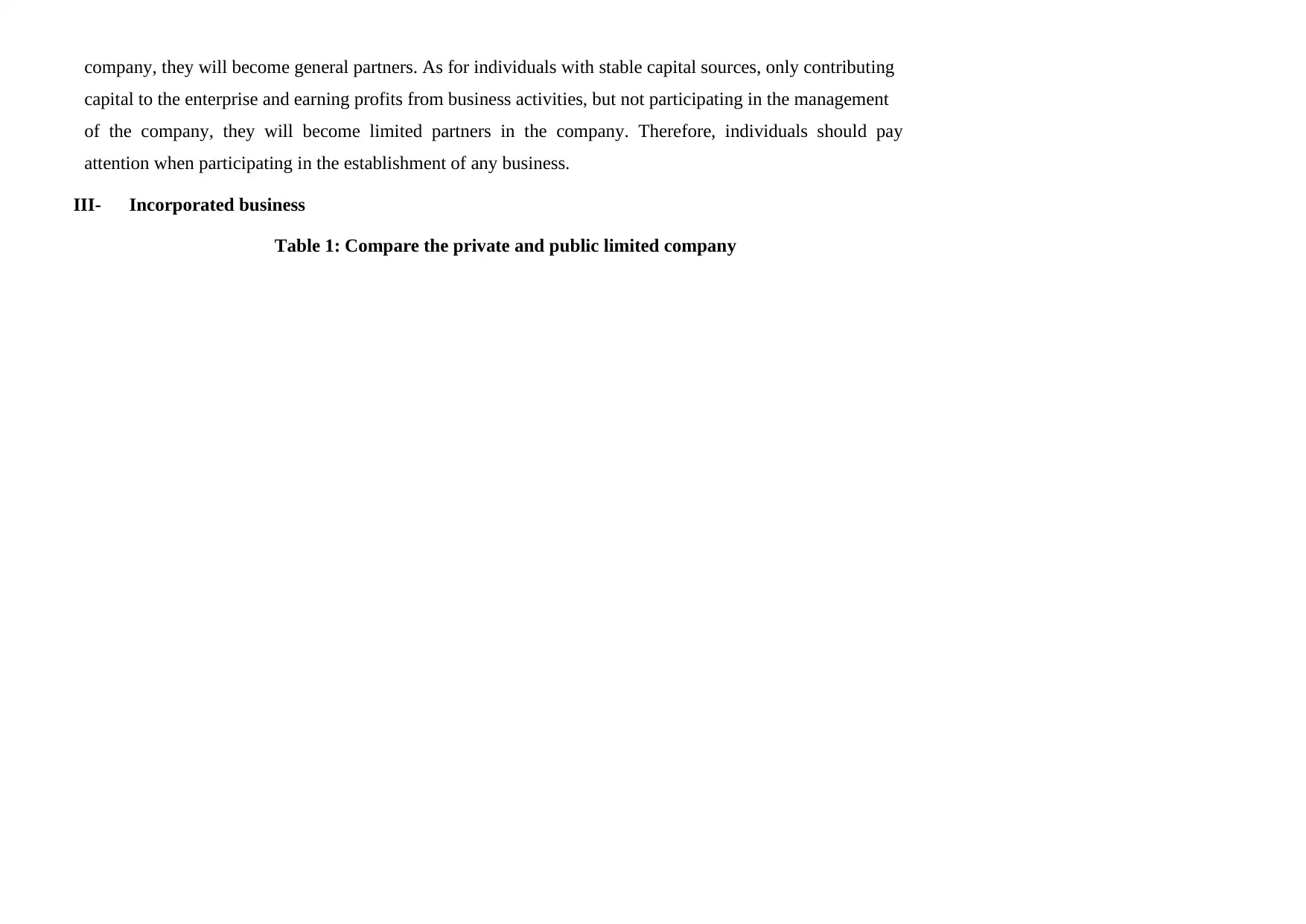
company, they will become general partners. As for individuals with stable capital sources, only contributing
capital to the enterprise and earning profits from business activities, but not participating in the management
of the company, they will become limited partners in the company. Therefore, individuals should pay
attention when participating in the establishment of any business.”
III- Incorporated business
“Table 1: Compare the private and public limited company”
capital to the enterprise and earning profits from business activities, but not participating in the management
of the company, they will become limited partners in the company. Therefore, individuals should pay
attention when participating in the establishment of any business.”
III- Incorporated business
“Table 1: Compare the private and public limited company”
⊘ This is a preview!⊘
Do you want full access?
Subscribe today to unlock all pages.

Trusted by 1+ million students worldwide
1 out of 54
Related Documents
Your All-in-One AI-Powered Toolkit for Academic Success.
+13062052269
info@desklib.com
Available 24*7 on WhatsApp / Email
![[object Object]](/_next/static/media/star-bottom.7253800d.svg)
Unlock your academic potential
Copyright © 2020–2025 A2Z Services. All Rights Reserved. Developed and managed by ZUCOL.





